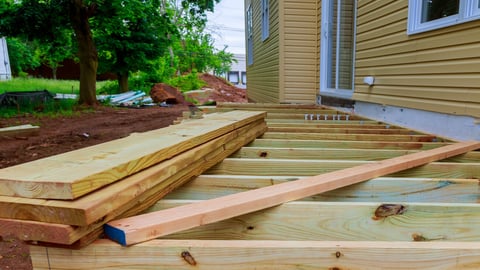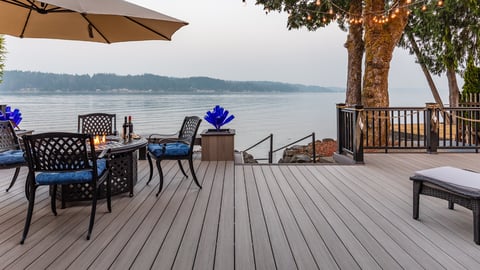Capturing the latest decking and outdoor living trends
Despite turbulent economic times, homeowners are still splashing cash to beautify their backyards. However, customers are increasingly doing more research, bidding out more quotes and taking their sweet time before committing to projects.
These are just a few key takeaways from a recent webinar hosted by Deckorators, which featured contractors from across the U.S. sharing insights and guidance on what they’re seeing and selling right now. The panel homed in on big trends that are currently shaping the industry. Read on for more tips from renowned decking pros.
Trend 1: “Wellness decks.”
Perhaps the hottest outdoor living trend right now is the notion of homeowners turning their backyards into health-minded oases. The contractors shared that they’re getting more requests to incorporate saunas, spas, outdoor showers, hot tubs, swim spas and cold plunge pools into their designs. Saunas in particular are taking off, according to Leif Wirtanen of Cascade Fence and Deck, which has locations in Oregon and Washington.
According to the contractors, they’re increasingly trying to highlight the health benefits of certain features and reinforce how much more people will utilize their space while enjoying “nature.” That nature-focused mindset should help drive the design when selling an outdoor living concept. Saunas, for instance, should have big windows, and hot tubs should have a nice view.
According to Michael Scott of Canada-based Simcoe Decks: “People increasingly don’t want to pay for wellness retreats and pricey gyms.” Instead, the idea is to create the spa or gym aesthetic right at home.
Trend 2: Multilevel decks (and outdoor rooms).
Multilevel decks are having a moment, it seems. The contractors stressed the appeal of featuring different “zones” of a decking project and incorporating multi-season use into the design (e.g., offering a shaded area and one area exposed to sunlight).
Other tips: Try to maximize usable space, minimize unneeded elements, and make sure stairs flow seamlessly from house to deck.
When selling a multilevel concept, the contractors advise, focus on easing the inside-to-outside transition, too.
Trend 3: Back to nature.
There’s a growing demand for backyards that mirror nature. For instance, one panelist shared about a decking project that incorporated a roof made with a clear polycarbonate to maintain the natural light.
Other trends on the rise include firepits, “secret garden” spaces with paver walkways, pergolas and other landscaping components that create a nature-centric backyard oasis. Fake plants are also increasingly popular, as people want the greenery pop without the work of upkeep, according to Sean Collinsgru of Philly-area Premiere Outdoor Living. He says his clients have been increasingly buying the “staging” plants his company uses for photos.
Color-wise, the contractors agreed they’re selling more browns and less gray these days. (Costa, in particular, has been selling like hot cakes out West, per Wirtanen.) As a panelist noted, “all wood eventually turns gray,” so if a customer likes a natural-looking brown, composite decking is an ideal choice.
Nature themes may be on the rise, but it’s crucial to consider comfort as well. Homeowners often still want heating or cooling components, TVs or windscreens when enjoying the great outdoors.
The panelists also said they’re seeing an uptick in requests for built-in benches with planter boxes and just planters in general.
Trend 4 Lighting.
Homeowners seem to crave creative, unique ways to illuminate their decks and outdoor spaces. That means lighted steps and pathways, illuminated pergolas, scope lights in trees and outdoor fireplaces.
Several of the panelists say they typically include (at least some lighting) in their projects, though there is upsell potential. Sometimes, it’s initially hard to sell the emotion of lighting until customers can see it at night in their own space, so it’s crucial to personalize illuminating flourishes. One panelist recommended leaving a customer a fixture for a night or two to let them experience the possibilities.
Natural light is important, too, making deck designs with skylights in roofs a smart choice.
As the panelists noted, technology in lighting has come a long way. Today, many lighting elements are “plug and play” and require the services of an electrician. In any case, it’s best to plan for lighting before building out a decking project, as it’s easier to do it up front rather than go back after the fact.
Cost is still king
Overall, “cost” remains the most essential factor of deck design. But as the panelists agreed, people are willing to spend right now; they are moving much more slowly. Projects aren’t getting smaller, per se, but people are doing more research and hesitating to commit to an overall budget. Customers are no longer rushing to get onto contractors’ schedules like during the COVID bonanza.
To boost sales, the contractors say they are reminding customers what they’re investing in and focusing on presenting tangible, substantive benefits (such as the meaningful, touchstone moments spent with family and friends). They’re also emphasizing the pros of composite decking, such as slip resistance, better color retention and less thermal movement than standard decking.
Overall, decking pros are having to work a lot harder for business. With the economy still in flux, that doesn’t seem likely to change anytime soon.





